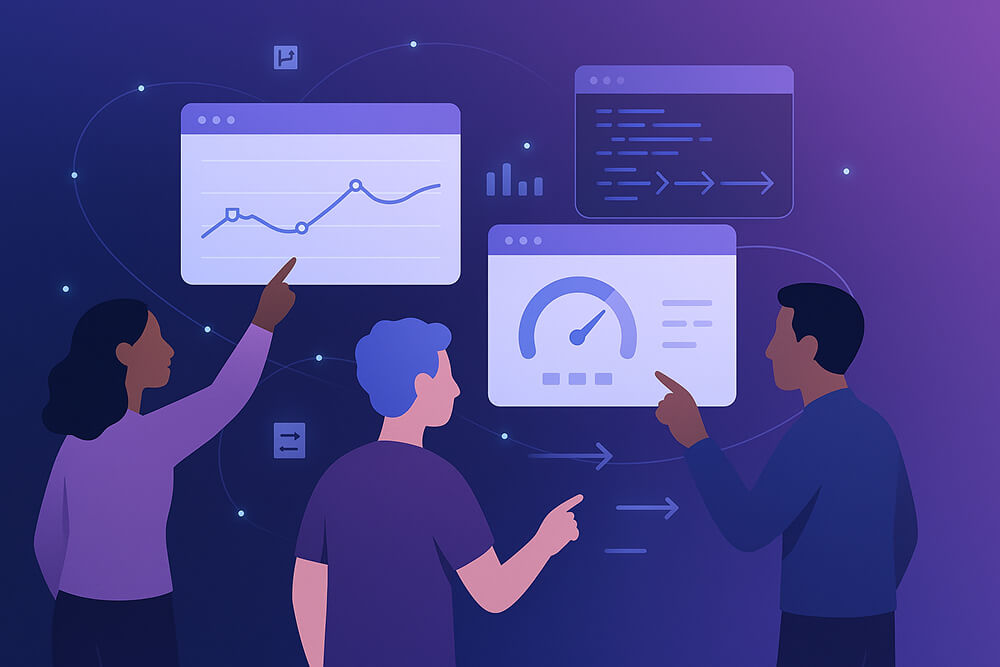
In 2025, software development is done on tight schedules and with real numbers. Every day, teams in different time zones send out updates to keep projects moving and customers interested. But this fast pace comes with its own problems: it’s easy to forget where tasks get stuck, hand-offs go wrong, or work goes to waste.
That’s where development analytics platforms come in. They help teams convert an ocean of commit, pull-request, CI/CD and incident data into clear, actionable insights. In this guide, we’ll spotlight the 10 development analytics tools you should know in 2025 to keep delivery predictable, productivity high, and your engineers happy.
What are Software Development Analytics Tools?
Software development analytics tools provide data-driven insights into the organization’s coding, continuous integration and delivery (CI/CD) pipeline, and development projects.
These tools help you understand:
- How much time during the last sprint was lost to rework, waiting, or failed tests?
- Which parts of the workflow cause bottlenecks?
- Whether code reviews, testing, and deployments are running efficiently and meeting quality thresholds.
- What quality or productivity trends are seen over a longer period of time?
Why Engineering Teams Need Analytics Systems
More than ever, modern development pipelines are automated. But things are still complicated; they’ve just moved. Teams now have to deal with numerous tools, environments that are spread out, and multiple integrations. Leaders often rely on their intuition instead of data when there isn’t a good analytics layer.
Here’s why analytics for developers matters in 2025:
- Identify bottlenecks early: Locate slow review stages, repetitive rework, or unbalanced workloads before they impact deadlines.
- Balance speed and quality: Instead of commit counts, which are vanity metrics, track real delivery metrics.
- Improve developer experience: Know the distribution of work and get rid of burnout by reviewing the load and the time of inactivity.
- Drive management by data: Eliminate the use of guessing when you are scheduling sprints or choosing the allocation of resources with the aid of data.
- Foster collaboration: Shared dashboards are the point of openness between engineering, product, and management.
Top 10 software development analytics tools in 2025
Below are ten standout tools that make a difference in how modern engineering teams track performance and identify bottlenecks.
1. LinearB

Best for: Measuring delivery metrics and workflow efficiency.
LinearB is still one of the most popular analytics tools for engineering teams. It connects directly to Git, Jira, and CI/CD tools, showing you how work moves through your system.
Key Features:
- Real-time cycle time and lead time tracking.
- “WorkerB” automation to alert teams on delays.
- Sprint progress forecasting and DORA metrics.
Why teams love it: Clear dashboards that highlight stuck pull requests and bottlenecks before they escalate.
2. Axify

Best for: Blending productivity metrics with developer well-being.
Axify stands out by focusing on team psychology. It examines not only process metrics but also developer sentiment.
Key Features:
- Sentiment analysis from daily pulse questions delivered in Slack
- Workflow analytics on review and delivery speed.
- Integrates with Slack and GitHub for daily updates.
Why teams love it: It bridges hard data and human context, a balance often missing in traditional tools.
3. Jellyfish

Best for: Turning engineering effort data into resource-allocation views that reflect business goals.
Jellyfish focuses on investment alignment, showing where engineering time actually goes.
Key Features:
- Breaks down work by strategic initiatives.
- Illustrates the investment ratios (features vs. maintenance vs. technical debt).
- Integrates with Git services, Jira/Azure Boards, major CI/CD and incident tools, plus product-road-mapping apps.
Why teams love it: Loved by CTOs and VPs as it helps them link engineering output to company strategy.
4. Pluralsight Flow

Best for: Developer-level performance and collaboration trends.
Pluralsight Flow, formerly known as GitPrime, provides extensive information on code reviews, commit activity, and teamwork.
Key Features:
- Review-time metrics such as PR Reaction Time and Iteration Time.
- Visualization of individual and team trends.
- Dashboards that show how your team’s metrics stack up against industry percentiles.
Why teams love it: Simple to read. The Sprint Movement report illustrates the evolution of progress and scope creep across multiple sprints.
5. SonarQube

Best for: Tracking code quality and maintainability.
The main focus of SonarQube is code health analytics. It identifies bugs, security vulnerabilities, and code smells across all connected repositories.
Key Features:
- Static code analysis for 30+ languages.
- CI/CD integration for automated scanning.
- Maintainability and reliability scoring.
- SonarQube also assigns a security rating (OWASP/SANS issues & hotspots).
Why teams love it: Provides measurable quality gates that prevent risky merges.
6. GitLab Insights

Best for: End-to-end analytics in a DevOps pipeline.
GitLab’s built-in insights show teams how often deployments happen, how many merge requests there are, and how issues are changing, all in one place.
Key Features:
- Built-in DORA metric tracking (available in the Ultimate tier).
- Merge request and pipeline analytics.
- Customizable reports for delivery speed and failure rate.
Why teams love it: Everything’s already integrated, no need for third-party dashboards.
7. GitHub Actions

Best for: Developers using GitHub for automation and CI/CD.
The Usage and Performance dashboards for GitHub Actions display key metrics, including the number of runs, average job duration, queue time, and success or failure rates for each workflow.
Key Features:
- Built-in graphs show the rate of job success, the average time it takes to build something, and trends in failures.
- YAML workflows or the marketplace Actions can send custom pipeline reports to problems, comments on pull requests, or artifacts.
- Optional PR-trend actions, such as Pull Request Stats, indicate the time required to review and merge.
Why teams love it: It works seamlessly with existing repositories and Actions workflows.
8. Microsoft Power BI

Best for: Building custom, cross-source analytics dashboards.
Power BI isn’t limited to software teams. But, when paired with the preview Git integration in VS Code or the Power BI Connector for Jira, it becomes a full-scale analytics hub for development data.
Key Features:
- 100+ connectors, from SQL Server and Azure Synapse to any REST/GraphQL API
- Custom visuals & DAX let you model complex engineering KPIs exactly the way you need.
- Drag-and-drop report canvas for rapid dashboard assembly.
Why teams love it: Great flexibility for companies that want a centralized reporting hub.
9. Oobeya

Best for: Delivery forecasting and project alignment.
The Japanese word “Oobeya” means “big room.” It is all about strategic visibility. It helps engineering managers monitor the flow of projects and delivery promises.
Key Features:
- Sprint-trend and velocity reports that sharpen delivery predictability.
- Resource Allocation dashboards that spotlight over- or under-loaded teams.
- One-click integrations with Azure DevOps, Jira, GitHub, CI/CD, and quality tools.
Why teams love it: Strong at turning project uncertainty into measurable predictability.
10. Code Climate Velocity

Best for: Enhancing code health and improving review efficiency.
Code Climate provides a detailed view of code churn, rework, and review participation, all of which are crucial for healthy development cycles.
Key Features:
- Code churn, review depth, and rework tracking.
- Review-process metrics (Initial-Review ratio, Review Speed, Time to First Review) spotlight slow or “rubber-stamp” approvals.
- Comparative benchmarking across teams.
Why teams love it: Balanced view between technical quality and team habits.
How to Choose the Right Analytics Tool
Choosing the right analytics tool depends on what you’re trying to improve. Not every team needs every metric. Some prefer high-level dashboards, while others want raw data to build their own insights.
Here are a few points to consider:
- Metrics coverage: Does it track cycle time, code quality, and review depth, or only one of them?
- Ease of integration: A tool that is directly connected to GitHub, GitLab, or Jira is a real time-saver.
- Scalability: Choose a platform that can scale with your team and workload.
- Developer experience: The best tools are not surveillance instruments. They provide feedback that can be used to improve the teams.
- Reporting flexibility: Prioritize solutions that allow custom dashboards rather than fixed views.
- Cost vs. value: Free tools like SonarQube or GitHub Insights are good starts, but paid ones like Jellyfish or LinearB offer deeper visibility.
FAQs
Q1. What criteria should you use to evaluate analytics tools for software development?
The first step is to ensure the tool includes all key engineering metrics, such as cycle time, churn, and review depth. Next, check if the tool allows you to connect your repositories without issues and if its dashboards are user-friendly. Also, consider how well the tool can scale and whether its pricing is flexible.
Q2. How do analytics tools help identify bottlenecks in engineering workflows?
They show where time is being wasted. For instance, long review periods or pull requests that need to be looked at. Tools like LinearB and Pluralsight Flow show these delays and send alerts so teams can do something about them before they affect delivery.
Q3. What are the trade-offs between open-source vs. commercial analytics tools?
SonarQube and other open-source tools are flexible and cheap, but you have to set them up and keep them running yourself. Commercial tools offer better integrations, nicer dashboards, and vendor support, making them ideal for larger or rapidly expanding teams.
Q4. How much effort is needed to integrate analytics tools into existing development pipelines?
OAuth makes it easy for most modern platforms to connect to GitHub, GitLab, or Jira in just a few minutes. Depending on your environment, it can take anywhere from a few hours to several days to fine-tune dashboards or sync data sources (for example, in Power BI).
Q5. Can these tools help improve developer satisfaction and productivity?
Yes. By removing manual reporting and offering clear, data-driven feedback, analytics tools let developers focus on meaningful work. Transparent insights foster fairness, collaboration, and continuous progress, key factors in developer happiness.
Conclusion
Writing good code isn’t the only thing that will make you successful in engineering by 2025. It’s knowing how the code goes from an idea to a release. Analytics tools show you every step, let you measure it, and make it easy to improve.
The goal remains the same, whether you use flow-metrics tools like LinearB, code-quality scanners like SonarQube, or Power BI’s flexible dashboards: to continually improve using data.
It’s not just the numbers that matter; it’s the insights. When teams know exactly where work is slowing down, they can fix problems faster, ship with confidence, and make better software together.


